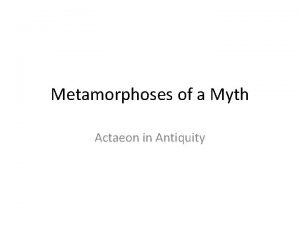The great tragedy of sciencethe slaying of a
































- Slides: 32

The great tragedy of science—the slaying of a beautiful hypothesis by an ugly fact. Thomas Huxley (1825 -1895)

Cholesterol Quiz True or False 1. The lower your cholesterol, the healthier you will be. 2. A healthy range of cholesterol is 0 -200. 3. Cholesterol helps protect against environmental toxins. 4. Cholesterol less than 150 significantly reduces your risk of heart disease. 5. The use of Statin drugs has lowered the incidence of heart disease.

Cholesterol Quiz (cont. ) 6. Oxidative stress and inflammation are the root cause of elevated LDL. 7. Your risk of death is two times higher with low cholesterol than it is with high cholesterol. 8. High insulin levels are a greater risk factor for CVD than high cholesterol. 9. The optimal cholesterol level is 225. 10. Cholesterol is a stand-alone test that can be used to determine health and disease.

What Is Cholesterol? u u Formed in the liver and synthesized in other cells. Byproduct of protein metabolism. Bonding oily fat (fat-soluble vitamins) to nitrogen via oxidation forms cholesterol. Cholesterol then transposes it into a lubricator, a hormone, antibody or enzyme.

Serum Cholesterol u u u Total amount of cholesterol that is being transported aboard the various lipoproteins. Serves as a rendezvous point for antioxidants and oxysterols. Serves as a colloidal stabilizer.

What Is Cholesterol Used For? u Bile production - 80% of cholesterol forms cholic acid. u Hormone production and transportation. u Source of energy along with glucose. u Production of cell membranes. u u Makes corneum of the skin to prevent water loss. Plays a role in the immune defense system.

Lipoproteins High Density Lipoproteins (HDL) Low Density Lipoproteins (LDL) Rich in cholesterol and carry some triglycerides u Repair in the body u Engulf toxins and then store in tissue cells u Rich in triglycerides and carry some fat u Hormone production u Engulf toxins and then store in tissue cells u At any one time the body can dictate the percentage of LDL vs. HDL

Saturated Fat Has No Impact on LDL Levels u u Fact one: The liver does not use fats, saturated, or otherwise to make cholesterol. Fact two: The liver does not make LDL, it makes VLDL. Fact three: VLDL is converted to LDL through triglyceride loss. Fact four: VLDL levels and LDL levels are totally unrelated. www. redflagsweekly. com/kendrick/2002_dec 12. html

The Answers

1. The lower your cholesterol, the healthier you will be. European Heart Journal Published 3 year study 11, 500 patients – Increase in lung cancer. – Increase in other cancers. – Higher risk of cardiac death. – Erectile dysfunction and infertility. – Loss of memory and mental focus. European Heart Journal 1997, 18, 52 -59

1. The lower your cholesterol, the healthier you will be. Swedish Researcher – Individuals with low cholesterol suffer from frequent and severe infections. – Individuals with high cholesterol had a lower mortality than the average population. Uffe Ravnskov, MD, Ph. D, independent researcher Magle Stora Kyrkogata 9, S-223250 Lund, Sweden

2. A healthy range of cholesterol is 0 -200. u If your cholesterol was 0 you would be dead. u Cancer risk for cholesterol levels: – Lowest risk >240 – Average risk 195 -210 – Increased risk <190 – High < 160 – Highest < 140

3. Cholesterol helps protect against environmental toxins. u University San Diego School of Medicine Study showed: – High cholesterol can be protective against environmental toxins rather than harmful. – Low cholesterol is a risk factor for heart arrhythmias. u High cholesterol readings are associated with protection from neurotoxins as well as cancer protection.

4. Cholesterol less than 150 significantly reduces your risk of heart disease. Journal of American Medical Association 30 years of follow-up from the Framingham Study: – No correlation between high cholesterol and mortality, but correlation between low cholesterol and mortality. – CVD death rates increased 14% for every 1 mg/dl drop in total cholesterol per year. Anderson KM. Cholesterol and Mortality, 30 years of Follow-up from the Framingham study. JAMA 1987 Apr 24; 257(16): 2176 -80

4. Cholesterol less than 150 significantly reduces your risk of heart disease. Journal of Cardiac Failure Paper on Low Cholesterol – Analysis of 1, 134 patients with heart disease – Low cholesterol was associated with worse outcomes in heart failure patients and impaired survival rates – Elevated cholesterol was not associated with hypertension, diabetes or coronary heart disease. – Horwich TB. Et. al. Low Serum Total Cholesterol is Associated with Marked Increase in Mortality in Advanced Heart Failure. Journal of Cardiac Failure 2002 Aug; 8(4): 216 -214

4. Cholesterol less than 150 significantly reduces your risk of heart disease. Japanese Study – Found as cholesterol levels went up death rates from CHD went down Okayama A. , Marmot MG Int. J Epidemiol Dec 1993

4. Cholesterol less than 150 significantly reduces your risk of heart disease. Low cholesterol readings are associated with: – Increased risk for for cancer stroke suicide symptoms from exposure to: u Neurotoxins u Mercury and other heavy metals u Cyclosporin

5. The use of statin drugs lowers your risk of heart disease. u u Despite successful attempts to lower cholesterol with statin drugs, the death rate from heart disease has not changed in 75 years. And mortality from heart disease is more than double what is was in 1996. Uri Goldbourt. Arteriosclerosis Vol 10. No 4. July/August 1990

Adverse Effects of Statins – Known carcinogens in experimental animals in doses approximate to those given to patients. – Increase risk of polyneuropathy 14 times. – Deplete Co. Q 10, lower antioxidant levels. – Liver dysfunction. – Muscle pain. – Memory loss, lack of concentration and global amnesia. – Insomnia, weakness and fatigue. – Erectile dysfunction. – Difficulty in managing diabetes, raises insulin levels. u Total annual sales of statins = $14 billion

Co. Q 10 and Statin Drugs u u u Statin drugs block the body’s ability to create Co. Q 10, and can lead to myopathy. Without Co. Q 10 your heartbeat would come to a screeching halt. Drug companies knew about this danger 13 years ago when they introduced the first statin drugs. The manufacturer of the second largest selling statin received two patents from the U. S. government for a Statin-Co. Q 10 combination. These patent numbers are 4, 929, 437 and 4, 933, 165.

u u u In its patent applications this drug company pointed out that statin drugs can lower the body’s levels of Co. Q 10, that this can cause myopathy, and that taking Co. Q 10 with the statin drugs can counteract this effect. For some reason, the company never marketed or publicized this statin/Co. Q 10 combination. If your taking statin drugs, you should take at least 50 mg a day of Co. Q 10. Then, you should consider weaning yourself off these drugs, under a doctor’s supervision.

6. Oxidative stress and inflammation are the root cause of elevated LDL. u u Artery walls must be damaged before arterial plaque is formed. LDL does not damage the endothelium (artery lining), oxidation does. LDL tries to repair the damage. u Cholesterol raises as a response to inflammation to protect the nerves and brain against exposure to fat soluble toxins and heavy metals u

6. Oxidative stress and inflammation are the root cause of elevated LDL. If you douse yourself in gasoline, will you burst into flames? u A group consuming American diet had lower antioxidant levels versus the Mediterranean diet which had increased antioxidant levels. u Mediterranean's had one-third the rate of heart attacks that Americans did. u Leon Study, Circulation, 1999, 99. Pg 779.

7. Your risk of death is two times higher with low cholesterol than it is with high cholesterol. u u Study with 11, 500 patients showed that the risk of death in the low cholesterol group (160 mg/dl and below) was 2. 27 times higher than those with high cholesterol. Most common cause of death in low cholesterol patients was cancer. European Heart Journal (1997) 18, 52 -59.

8. High insulin levels are a greater risk factor for CVD than high cholesterol. u High levels of the stress hormone cortisol along with high insulin levels creates the metabolic state that causes atherosclerotic plaque development. The French Paradox by Hugh Tunstall-Pedoe 1978 u Triglycerides/HDL = >3 is an indicator of hyperinsulinemia

9. The optimal cholesterol level is 225. u u u According to the latest lab values, the new range is 0 – 169. If your cholesterol was 0 you would be dead. Normal suggestion is 175 – 275.

10. Cholesterol is a stand-alone test that can be used to determine health and disease. u Cholesterol is affected by many organs and glands and in itself is not a reliable indicator as to what is going on in the body as a whole.

High Cholesterol u u u Inflammatory Response. Protects the nerves and brain against exposure to fat-soluble toxins and heavy metals. Oxidative stress. Excessive hydrogenation of fats in the stomach altering the pepsin/HCl balance. Hypothyroid condition.

High Cholesterol u § • • Lubricator proteins are not being broken down properly or combustion is not available at the following levels: Proper digestion and the preparation of proteins to be assimilated into the bloodstream. Preparation and formation of cholesterol in the liver. Cellular level for hormone production/penetration/ impact on body metabolism. • Hypofunctioning ant. pituitary/hypothalamus gland. u Bile emulsification condition.

Low Cholesterol u Oxidative Stress. u Heavy Metal Poisoning. u Free Radical Damage. u Cancer. u Fat is congested in the liver and is not able to be metabolized due to congestion and swelling in the sinusoids. u The iodine is failing to release the nitrogen bond. u Imbalance of the Pepsin/HCl ratio. u Congestion in the digestive tract due to bile salt inadequacy. u Hyper-functioning pituitary or hypothalamus.

High HDL u Exposure to pesticides (>90). Low HDL Increased Toxicity Risk. u Constipation. u Not enough exercise. u High sugar/high carb/low fat intake. u

CHOLESTEROL PROTOCOLS General Support: u Cholaplex – 3 capsules 3 times daily with meals. u Soy Bean Lecithin – 2 perles 3 times daily with meals. u Linum B 6 – 5 perles 3 times daily with meals. u Cyruta – 2 tablets 3 times daily with meals. u Garlic – 1 capsule 3 times daily with meals. u Vitanox - 1 tablet 3 times daily with meals. Liver/Gall Bladder Support: u Livaplex – 2 capsules 3 times daily with meals. u AF Betafood – 2 tablets 3 times daily with meals. Thyroid Support: u Thytrophin – 1 tablet 3 times daily with meals. u Allorganic Trace Minerals - 1 tablet 3 times daily with meals. u Bladderwrack - 5 m. L 3 times daily.
 General jackson slaying the many headed monster
General jackson slaying the many headed monster Slaying dragons destiny 2
Slaying dragons destiny 2 Actaeon
Actaeon Judith slaying holofernes
Judith slaying holofernes Origin of greek drama
Origin of greek drama Shakespeare comedy vs tragedy
Shakespeare comedy vs tragedy Characteristics of tragedy drama
Characteristics of tragedy drama Mật thư anh em như thể tay chân
Mật thư anh em như thể tay chân Tư thế ngồi viết
Tư thế ngồi viết Gấu đi như thế nào
Gấu đi như thế nào Thẻ vin
Thẻ vin Thể thơ truyền thống
Thể thơ truyền thống Các châu lục và đại dương trên thế giới
Các châu lục và đại dương trên thế giới Sự nuôi và dạy con của hổ
Sự nuôi và dạy con của hổ Từ ngữ thể hiện lòng nhân hậu
Từ ngữ thể hiện lòng nhân hậu Diễn thế sinh thái là
Diễn thế sinh thái là Thế nào là giọng cùng tên
Thế nào là giọng cùng tên Vẽ hình chiếu vuông góc của vật thể sau
Vẽ hình chiếu vuông góc của vật thể sau 101012 bằng
101012 bằng Lời thề hippocrates
Lời thề hippocrates Tư thế worm breton là gì
Tư thế worm breton là gì đại từ thay thế
đại từ thay thế Quá trình desamine hóa có thể tạo ra
Quá trình desamine hóa có thể tạo ra Công thức tính độ biến thiên đông lượng
Công thức tính độ biến thiên đông lượng Thế nào là mạng điện lắp đặt kiểu nổi
Thế nào là mạng điện lắp đặt kiểu nổi Dot
Dot Bổ thể
Bổ thể Vẽ hình chiếu đứng bằng cạnh của vật thể
Vẽ hình chiếu đứng bằng cạnh của vật thể Biện pháp chống mỏi cơ
Biện pháp chống mỏi cơ Phản ứng thế ankan
Phản ứng thế ankan Khi nào hổ mẹ dạy hổ con săn mồi
Khi nào hổ mẹ dạy hổ con săn mồi Thiếu nhi thế giới liên hoan
Thiếu nhi thế giới liên hoan





















































